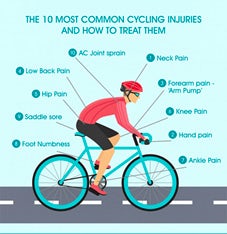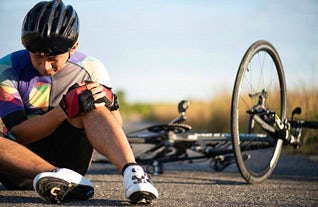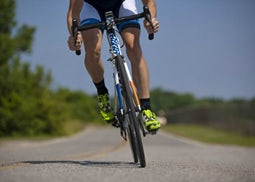
Tips for Avoiding Cycling Injuries
If you are a cyclist, you may be aware that varying degrees of injuries are common, and will likely always be common. If you are an avid cyclist, you may also admit that getting off the bike may be difficult, even with an injury. Below we will discuss some common cycling injuries, how to avoid them and when to seek help. It is important to remember that your body is one big system and symptoms present may not be the actual source of pain or discomfort.
Common Cycling Injuries
Lower Back Pain
 Hours curled over the handlebars means that one of the most common injuries in cyclists is low back pain. If you also have a job which requires long hours sitting at a desk or sustained awkward positions, this can exacerbate the pain. Low back pain can often lead to poor posture which in turn has numerous domino effects on the body and may potentially cause other injuries.
Hours curled over the handlebars means that one of the most common injuries in cyclists is low back pain. If you also have a job which requires long hours sitting at a desk or sustained awkward positions, this can exacerbate the pain. Low back pain can often lead to poor posture which in turn has numerous domino effects on the body and may potentially cause other injuries.
There is one muscle in particular which can attribute to low back pain in cyclists – the piriformis. The piriformis muscle may be irritated by prolonged sitting, inactivity or repetitive movements of the legs. Irritation of the piriformis muscle may present as hip pain, low back pain and it even has the potential to entrap the sciatic nerve causing sharp pain down the back of your leg.
How to Prevent Low Back Pain for cyclists:
- Spend some time stretching your back and using a foam roller to assist with low back pain attributed to tightness
- You may want to consider changing your position on the bike – raising the handle bars will help to alleviate pressure on your back
- If your back pain is exacerbated by a desk job, consider investing in a McKenzie Pillow. This is a round pillow which sits in the small of your back while you are seated at a desk to help maintain good posture. You may want to also assess the ergonomics of your work station.
- Increase your core strength. If you have weakness in your core, it will cause stress through your back while cycling.
Knee Pain
 The knee is a very common place for cyclists to experience pain. It is possible to treat knee pain with rest, ice, foam rolling, strapping and stretches; however, it is important to identify the cause of the knee pain to avoid reoccurrence.
The knee is a very common place for cyclists to experience pain. It is possible to treat knee pain with rest, ice, foam rolling, strapping and stretches; however, it is important to identify the cause of the knee pain to avoid reoccurrence.
What may be Causing my Knee Pain?
- Knee pain felt at the front of the knee is often caused by an increase stress through the knee cap. This may be caused by a saddle which is too low.
- Pain felt behind the knee may be caused by a saddle which is too high, placing undue strain through the hamstring group.
- Pain felt on either the inside or outside of the knee can often be caused by the use of an incorrect cleat, causing the knee to track incorrectly whilst pedaling.
- Pain felt on the outside of the knee and down the outside of the upper leg may be attributed to a tight iliotibial band (ITB). The ITB is fibrous tissue which has a number of muscle attachments to it. It attaches to the outside of the knee and when tight, can pull on the knee cap causing incorrect tracking. This may be effectively resolved with massage, foam rolling and kinesio taping of the knee.
Foot Pain
With the amount of force put though the foot during every pedal, it shouldn’t come as a surprise that foot pain is common in cyclists. Cyclists will describe this pain as “hot foot” as it is a burning, numbness or pain in the sole of the foot. There are a number of causes of “hot foot” including pressure through the nerves at the bottom of the foot, stretching of the connective tissues at the bottom of the foot and swelling.
How to Prevent Foot Pain:
- If you are experiencing pain on the sole of your foot/feet while cycling during summer, it is likely that your feet are swelling. To resolve this, it may help to loosen your shoes or to look for shoes which have a bit more width.
- If you are experiencing pain during winter and you are wearing socks that are too thick, there may not be enough blood flow to your feet. Again, you may want to invest in wider shoes, or perhaps thinner socks.
- Cleats with a larger platform allows pressure through the feet to be spread more evenly and widely. If you are experiencing foot pain, it may be worth exploring your options to see if it helps alleviate your foot pain.
- Plantar fasciitis is also a common condition seen in cyclists which may present as pain in the sole of the foot. The plantar fascia is a thick band of connective tissue running along the sole of the foot which functions to tighten as you step (or pedal) to allow even distribution of force through the sole of the foot. If it is damaged due to stress or it becomes tight, it can become painful. Foam rolling the sole of the foot with a tennis ball, stretching your foot and icing your foot may help to relieve the pain. If this does not alleviate your pain, you may want to consider custom insoles which support the arch in your foot and prevent undue stress.
Wrist, Arm, Hand and Neck Pain
It is suggested that 60% of your body weight is positioned at the rear end of the bike, while the remaining 40% of weight is positioned at the front. If there is excess weight at the front half of the bike, your arms and wrists may end up injured and sore.
Causes of Upper Body Pain in Cycling.
- Reach is too long and handles are too low. If this is the case, your body weight will be shifted excessively to the front half of the bike. It may also cause you to hyperextend your neck when looking up, causing neck pain.
- Incorrect handlebar positioning. If your handlebars are positioned such that the hand is placed in an unnatural angle, you may begin to experience wrist pain and potentially numbness and tingling into the pinky and ring finger as a result of an entrapped ulnar nerve. This is commonly referred to as “handlebar palsy” in cyclists. If there is resultant compression of the median nerve, you may experience numbness and tingling into the thumb, index and middle finger. Cycling mitts may help to prevent compression of a nerve, however it can become an ongoing issue so it’s always a good idea to see your chiropractor about it.
Recovery
 You may decide to see your chiropractor to prevent your pain from becoming persistent and to address the underlying cause of your pain. While it is important to address the physical and mechanical aspects of your injury, we also have a number of additional tips to help you on your journey.
You may decide to see your chiropractor to prevent your pain from becoming persistent and to address the underlying cause of your pain. While it is important to address the physical and mechanical aspects of your injury, we also have a number of additional tips to help you on your journey.
- Track your Goals
Setting and tracking realistic goals allows yourself to be accountable for your progression and may also help you achieve better outcomes sooner. You may set a weekly distance, time or elevation goals. You could also choice to mix these targets up or alternate through them weekly. - Socialise
Just because you aren’t able to cycle with your usual group that doesn’t mean you can’t catch them at their end-of-ride coffee! The social aspect of cycling is just as important as the physical side and it is important that you are still able to enjoy the social aspect of what you love. - Maintain an Adequate Diet
If you cycle regularly, you may be eating a lot of food to fuel the calories that you are burning. While you are recovering it may be challenging to adjust this. It is important to maintain a diet which addresses the body’s immune response and any inflammation as well as protects muscle mass. Protein and creatine supplements may assist with the latter, while a diet high in plant based foods, omega-3 and antioxidants may assist with inflammatory processes associated with injury.
Our chiropractors at Lakeside Chiropractic are well equipped with the skills and knowledge to assist you in your recovery and preventing recurrence of your cycling injury. We provide massage, kinesiology taping, stretches, home strengthening exercises and advice to help you get back to what you love! If you have any queries or would like to book and appointment call us on (08) 9300 0095 or book online at www.lakesidechiro.com.au.
Schedule an Appointment


